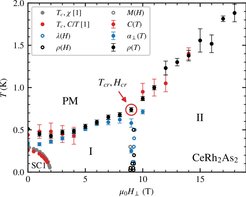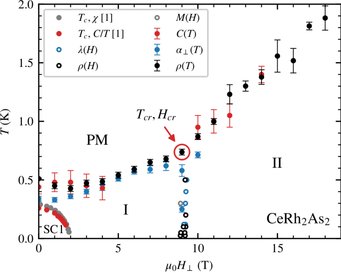Quadrupole Density Wave
Experiments show that the unconventional superconductor CeRh2As2 may host a “quadrupole density wave” - a theorized complex ordering pattern among free electrons that has not yet been observed.
Free conduction electrons in a periodic environment - such as a crystalline metal - can organize themselves into ordered states with a spatial modulation of their charge or magnetic dipoles. Such ordered states are called charge density waves and spin density waves, respectively. Basic electrodynamics allows for patterns more complex than a point charge or a magnetic dipole, such as electric quadrupoles. However, free electrons do not carry quadrupoles and, accordingly, a quadrupole density wave formed by conduction electrons has not been reported yet. An international team of scientists from France and Germany (MPI-CPfS Dresden) has shown that exactly such a quadrupole density wave probably occurs in the material CeRh2As2.

Thermodynamic and transport properties were determined across the ordering temperature from the normal state into the quadrupole density wave state (phase I in the figure). Several unusual findings point to a quadrupole density wave: the absence of an anomaly in magnetic probes, the increase of the transition temperature with magnetic field, and a transition temperature increase with pressure that could be predicted from the results. Renormalized band structure calculations could show that a quadrupole density wave can exist in metals in which atomic-like “local” electrons hybridize with conduction electrons. Under these conditions, the quadrupole of the local electrons is partially transferred to the conduction electrons. Our calculations show that CeRh2As2 is particularly prone to the formation of a quadrupole density wave.
Previous work has shown that this material enters an extraordinary superconducting state with two distinct superconducting phases. Our work raises the interesting question of how the quadrupole density wave is related to this superconducting state.
DH & MB












